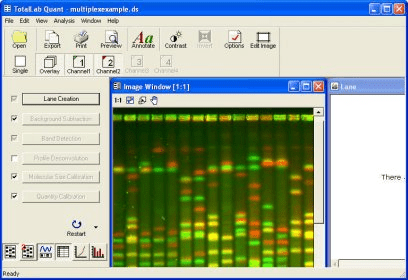

Ĭ-1(2)-dehydrogenation of steroids is an important bioconversion reaction catalyzed by microorganisms.

Imagequant tl download software#
Quantification of α-tocopherol and ergocalciferol by TLC, scanning and processing of the chromatogram with video densitometry software has also been reported. Detection limits of TLC are often low and quantitative densitometric methods are accurate.Ĭommon office scanners are frequently used as densitometers for scanning stained TLC plates followed by processing the digital image by image analysis software. It does not require UV activity, paramagnetic properties or volatility as mandatory for LC, NMR and GC quantification respectively, making TLC one of the most powerful and general analytical tool. Many samples can be analyzed simultaneously and quickly by TLC. Thin-layer chromatography (TLC) is an important tool for qualitative analysis of various analytes because of its inherent advantages. All these methods are time-consuming and involve sophisticated instrumentation. Number of methods have been employed for quantification of exemestane in samples of human urine by gas chromatography/mass spectrometry and liquid chromatography/tandem mass spectrometry, in human plasma by LC-MSMS, in various pharmaceutical dosage forms and stability testing by HPTLC, HPLC and RP-HPLC.

have reported C-1(2)-dehydrogenation of 6-MeAD to exemestane by of several bacterial strains. The later is an eco-friendly route that eliminates the use of toxic chemicals and side products formed during chemical synthesis. Alternative route of microbial C-1(2)-dehydrogenation of 6-methylene androstenedione (6-MeAD) to yield exemestane has been developed and patented. However, the chemical synthesis involves multiple steps and use of hazardous chemicals during the final step of C-1(2)-dehydrogenation, making it undesirable. The synthesis of exemestane is based on chemical conversion of a variety of steroid substrates.
Imagequant tl download license#
This is an open access article under the CC BY license ()Įxemestane, a third generation steroidal aromatase inhibitor, is a widely used drug for the treatment of breast cancer in postmenopausal patients. Published by Innovare Academic Sciences Pvt Ltd. Keywords: TLC image analysis, 6-Methylene androstenedione, C-1(2)-Dehydrogenation, Exemestane, Rhodococcus rhodochorus MTCC 291 MTCC 1534, Pseudomonas putida MTCC 1194 and Rhodococcus rhodochorus MTCC 291 respectively yielded 79.7 (72 h), 63.9 (72 h), 69.8 (96 h) and 83.2 (96 h) mole percent bioconversion of 6-methylene androstenedione to exemestane.Ĭonclusion: Rhodococcus rhodochorus MTCC 291 was found to be the most suitable organism for the bioconversion and may be used to develop an eco-friendly route to replace chemical synthesis that eliminates the use of toxic chemicals and side products. Bacterial strains Arthrobacter simplex IAM 1660, Nocardia sp.

Results: The percentage error between TLC and HPLC analyses was ranged from (-) 5.18 to (+) 5.51. Methods: After microbial bioconversion and TLC separation of products formed, exemestane was quantified using ImageQuant TL v2003 image analysis software and the results were compared with high performance liquid chromatography (HPLC) analysis. Objective: The present study was aimed at developing a rapid, cost effective and accurate method for quantification of exemestane using thin layer chromatography (TLC) separation followed by image analysis and to test it for monitoring the accumulation of exemestane during microbial bioconversion. QUANTIFICATION OF EXEMESTANE ACCUMULATION DURING MICROBIAL BIOCONVERSION BY TLC IMAGE ANALYSIS PRACHI PATIL 1*, RAJESH SHARMA 1, TUSHAR BANERJEE 2, SHRIDHAR PATIL 2ġSchool of Pharmacy, Devi Ahilya University, Indore, India, 2School of Life Sciences, Devi Ahilya University, Indore 452001, India Int J Pharm Pharm Sci, Vol 9, Issue 8, 105-109 Original Article


 0 kommentar(er)
0 kommentar(er)
